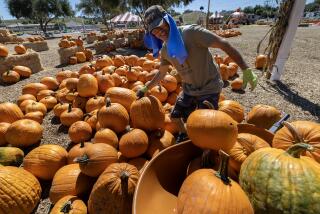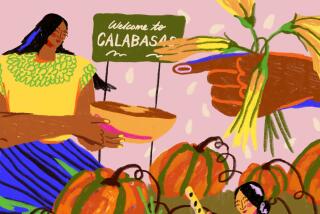The Great Pumpkin Tale
The scariest moment of Halloween has to be sticking your hand into the cold cavity of a pumpkin to pull out the strings and seeds. Itâs slimy in there, moist, tangled, purely other. The seeds spurt through your fingers like live fleet polliwogs. The smell is heavy and damp, at once cheese-like and sweet, almost cloying.
The requisite evisceration of every future jack-oâ-lantern is oddly and appropriately symbolic; after all, Halloween is an old druidic holiday signifying a time when the dead flock back to mingle with the living. Jack-oâ-lanterns, with their spectral human leers, signify the restless souls of the dead who wander the Earth.
In Ireland, before pumpkins were introduced from the New World, jack-oâ-lanterns were made from scooped-out rutabagas, turnips, even potatoes. A vegetable, lighted from within, casts a particularly eerie glow.
The legend of the jack-oâ-lantern starts with a drunkard named Jack--a thieving, stingy, sharp-tongued drinking man who had no intention of paying for his evil ways.
One day, he cleverly talked the devil into climbing a tree. Once the devil was well up into the tree limbs, Jack carved a cross in the trunk. The devil, then, could not get down. The cross held him jailed in the leafy branches. The devil cursed and threatened Jack, then wheedled and pleaded and finally reached a bargaining mode.
Jack agreed to release the devil from the tree if the devil, in turn, promised not to take Jack to hell.
Drinking, thieving and being just as stingy and nasty as he always was, Jack lived to a ripe old age and died, unrepentant and fearless about his pending life after death. He went directly to heaven, where, to his astonishment, he was refused admittance.
He had been too miserly and cruel, and besotted besides. No way could he pass through the Pearly Gates. After some confused and lonely roaming, Jack actually made his way down to hell and knocked on the devilâs door. But the devil had made a promise and would not go back on it. Jack was not welcome in hell either.
After Jack was refused at both heaven and hell, so the story goes, he was so desolated that even the devil took pity on him and tossed him a live coal from the fires of hell to light his way. Jack popped the coal inside a turnip he was eating, and used it to see the path of his endless journey. This ghostly light, seen by lone travelers late at night, often near swamps, is said to be Jack, eternally searching for a place where he belongs.
The jack-oâ-lantern is closely associated also with the will-oâ-the-wisp. But in the latter case, the light was created by a fellow named Will who lighted a handful of straw.
Will-oâ-the-wisps, and also something called the friarâs lantern, appeared around swamps and bogs and were said to hypnotize and draw wanderers to a marshy death. Some said these lights were the spirits of the dead searching for other bodies to occupy; others said they were the spirits of stillborn children or spirits of the dead seeking revenge, comfort, a place to rest, a home.
In Latin, these lights were called ignis fatuus, foolish fire, so named because people foolishly mistook them for the lights of warm and cozy cottages and, drawn to them, perished in the bogs. Today we know that the ephemeral phosphorescent lights seen in swamps are caused by the spontaneous combustion of gases released by decaying plants.
Closely related to jack-oâ-lanterns, will-oâ-the-wisps and friarâs lanterns are corpse candles and fetch lights, which appear as small flames moving through the air in the dark; those who see these lights, it is said, will die shortly thereafter.
In time--probably in the 19th century, when pumpkins became commonplace in Europe--the jack-oâ-lantern became inextricably associated with the pumpkin and with carved, back-lit grins. Spookiness became mediated by jollity.
The size of pumpkins, their weight, the individuality of each specimen--especially when carved--add up to an inherent, inescapable reference to the human head. In âThe Legend of Sleepy Hollow,â the headless horseman runs down the psalm-warbling Ichabod Crane and, once upon the bony schoolteacher, hurls his head at him. The morning light reveals a smashed pumpkin on the road.
In âThe Marvelous Land of Oz,â L. Frank Baumâs first sequel to âThe Wizard of Oz,â one of the main characters is the awkwardly constructed, eternally grinning Jack Pumpkinhead, an agreeable naif who worries incessantly about spoiling. Pumpkins also appear in folk tales worldwide as horse eggs, or at least the objects that fools mistake for horse eggs.
The pumpkin patch itself is a mythical realm. I once knew an older woman named Viola who was courted by a character named Bud. Bud had a long, white, luxuriant beard. He proposed to Viola, but she would not accept him unless he cut off his beard. With it, she said, he looked like he lived in a pumpkin patch. (No, they did not marry.)
And then there is Peter Pumpkineater, whose presumably small runaway wife was finally securely confined in a pumpkin shell.
People in North America have probably been harvesting some strain of pumpkin or other for 9,000 years. They were definitely cultivating them in the Tehuacan valley of Mexico between 5000 and 2500 BC. Montezuma is said to have served them at his table. The Aztecs preserved both the seeds and the flesh for later use, grinding the seeds and drying the flesh in strips. They also dried whole pumpkins out to use as water jars and cooking vessels.
European explorers noted these large New World gourds in the 16th century. The English naturally called them pompions, using the word they had applied to the gourds of the Old World. And thatâs where our word âpumpkinâ comes from, though true pumpkins are strictly New World vegetables and were unknown in Europe or Asia before the time of Columbus.
Pumpkins--indeed, squash in general--may have been of great interest to 16th and 17th century botanists, but Europe at large did not begin to eat them with enthusiasm until the 19th century. Since then, pumpkin has found its way into puddings and pies, casseroles and ravioli, ice cream and candy. Pumpkin is featured prominently in Italian cooking, but the French have never fully embraced it--or, for that matter, any sort of winter squash.
In addition to being a versatile vegetable, the pumpkin is said to have curative properties: a poultice of stewed pumpkin is supposed to relieve inflammation. And pumpkin seeds are reported to rid the body of tapeworms.
Taxonomically speaking, the pumpkin is classified as a strain of Cucurbita pepo, along with similar squashes. This will probably not matter a whit to you unless you are a pumpkin oâphile--perhaps one of the growing army of giant-pumpkin growers.
The giant pumpkin is no myth. This is the first year that anyone has entered into competition a pumpkin weighing over 1,000 pounds. Photographs of competing pumpkins show huge slumped, ribbed specimens; they share the same flaccid, mountainous presence as the fantastically overweight humans one sees on the cover of tabloids.
It would seem that the men who grow these half-ton pumpkins--and growing giant pumpkins does appear to be an exclusively male sport--took to heart the nursery rhymes and fairy tales of their childhoods. It is as if they believe in the possibility of a wife-sized container or a poor girlâs coach. (A book on giant-pumpkin growing has a photograph of one growerâs wife curled up in a pumpkin shell.)
Yet some of these growers have spent five to eight hours a day in their pumpkin patches, feeding, weeding, cultivating, fighting fungus on and generally communing with their growing pumpkins only to have their coddled, enormous specimens disqualified as squash.
Pumpkin. Squash. The question is, would Cinderella care?
PUMPKIN BUTTER
1 (9 1/2- to 10-pound) pumpkin
3/4 teaspoon salt
4 to 5 teaspoons ground cinnamon
1 teaspoon ground ginger, or more to taste
1/2 teaspoon ground nutmeg, or more to taste
1/2 teaspoon ground cloves, or more to taste
4 to 5 tablespoons cider vinegar
2 1/2 cups brown sugar, packed
2 tablespoons molasses
This comes from Anna Thomasâ book âThe New Vegetarian Epicureâ (Knopf, 1996). She describes it as âfat free with a wonderfully rich flavor.â Itâs great on toast, especially with cream cheese. This recipe makes enough for the family and a few gifts for friends.
Cut pumpkin in half and scrape out seeds. Put pumpkin halves, cut side down, in lightly oiled baking dish. Bake pumpkin at 400 degrees until soft when poked with wooden spoon, about 1 hour.
Remove from oven and cool slightly, then scoop soft flesh out of rind. Be sure not to get pieces of rind into mix. You should have 8 to 10 packed cups of cooked pumpkin.
Combine pumpkin, salt, cinnamon, ginger, nutmeg, cloves, vinegar, sugar and molasses in large non-reactive, heavy-bottomed pot. Bring to simmer and stir over low heat 20 to 30 minutes. As flavors marry and excess moisture cooks away, adjust vinegar and sugar to taste. Pumpkins vary in flavor and sweetness.
Puree mixture in batches in blender and taste again; correct seasoning if necessary and cook puree down little more if thin; it should hold soft shape.
Spoon hot pumpkin butter into sterile canning jars, screw on new, scalded lids and process in boiling water bath at least 20 minutes, or according to manufacturerâs instructions. Pumpkin butter can also be frozen in small batches or simply kept in tightly covered containers in refrigerator for several weeks. Butter develops best flavor after few days.
Makes 8 to 10 cups of thick pumpkin butter.
Each 1-tablespoon serving from 8 cups contains about:
17 calories; 15 mg sodium; 0 cholesterol; 0 fat; 4 grams carbohydrates; 0 protein; 0.24 gram fiber.
PUMPKIN IN SYRUP
1 1/2 cups water
4 pounds piloncillo (Mexican brown sugar cones) or 10 1/2 cups dark brown sugar, packed
1 (10-pound) pumpkin
This recipe comes from âFriedaâs Fiestasâ by Guadalupe Rivera and Marie-Pierre Colle (Potter, 1994).
Combine water and sugar in saucepan. Cook over low heat, stirring often, to make syrup.
Peel pumpkin and cut in chunks. Remove fibers and seeds. Score pulp in diamond shapes. Arrange pumpkin chunks in large saucepan. Add syrup, cover and cook over medium heat, stirring occasionally, until pumpkin is well soaked in syrup and is deep caramel color, about 2 1/2 hours.
Makes 24 servings.
Each serving contains about:
266 calories; 20 mg sodium; 0 cholesterol; 0 fat; 69 grams carbohydrates; 1 gram protein; 1.25 grams fiber.
ROASTED PUMPKIN SEEDS
There are several methods for roasting and/or toasting pumpkin seeds. Before attempting any of these methods, remove seeds from pumpkin. Try to remove as much of the strings and juice as possible, but donât be overly finicky; a few threads will shrivel up and separate easily in the roasting.
Dry-roast seeds in heavy, ungreased skillet over medium heat, stirring constantly, 5 to 10 minutes. For salted seeds, sprinkle with brine (1/2 teaspoon salt dissolved in 1/4 cup water) while roasting; seeds will get nice thin coat of salt as water evaporates.
* For tastier seeds, roast in skillet as above but add 1 tablespoon vegetable oil per cup of seeds. Salt to taste.
* Soak seeds in salty water (salt to taste) at least 8 hours, drain and dry on paper towels, then roast on baking sheet at 350 degrees, stirring frequently, until done, about 15 or 20 minutes.
* Roast seeds on baking sheet with 1 tablespoon olive oil per cup of seeds at 325 degrees, stirring frequently until done, about 20 to 25 minutes.


